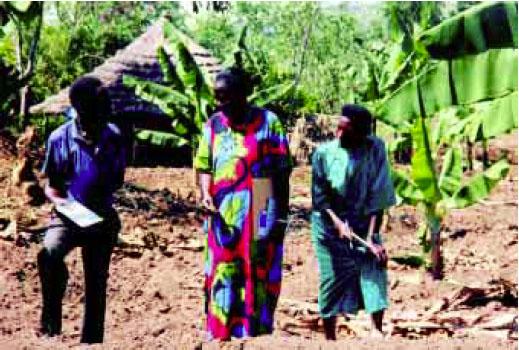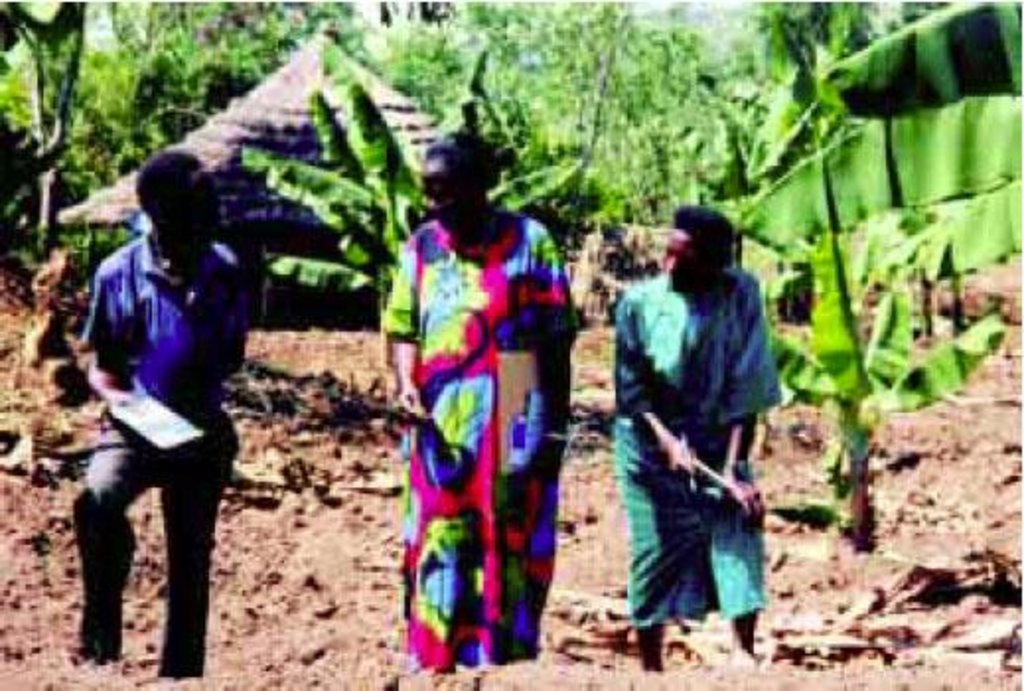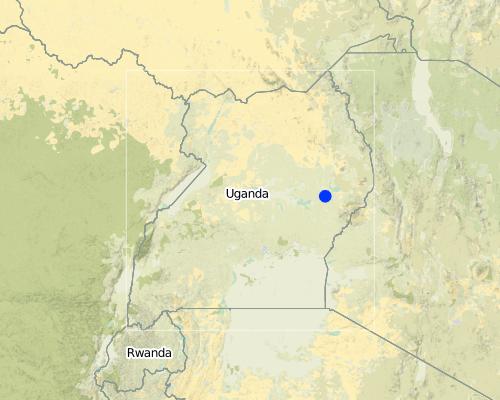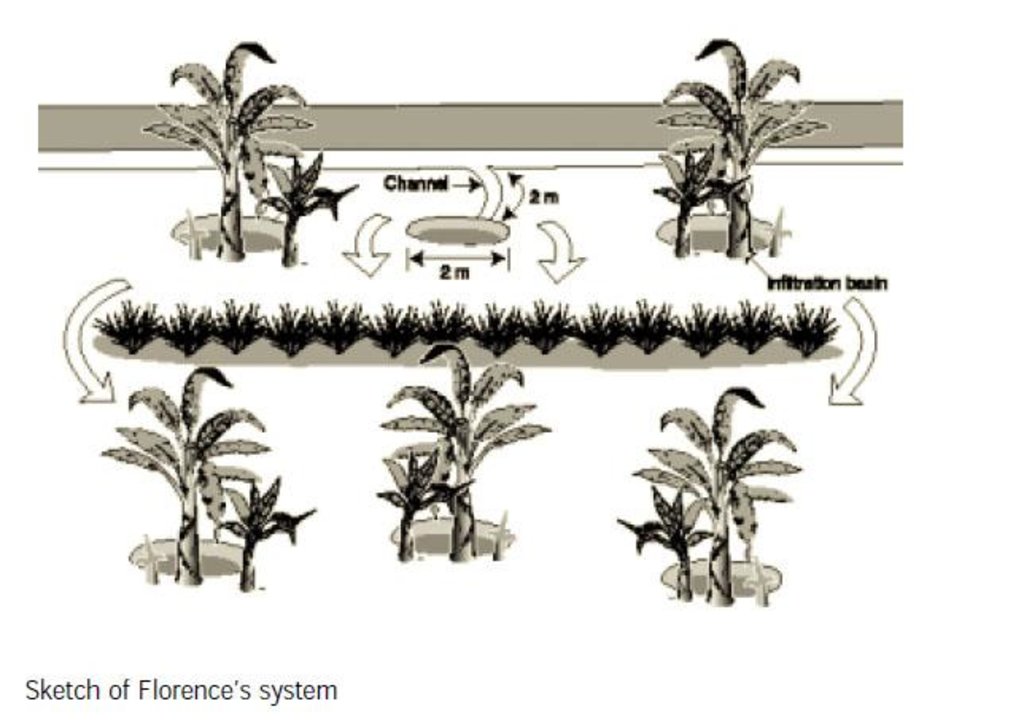Runoff water harvesting for bananas [乌干达]
- 创建:
- 更新:
- 编制者: Alex Lwakuba
- 编辑者: –
- 审查者: Fabian Ottiger
technologies_1390 - 乌干达
查看章节
全部展开 全部收起1. 一般信息
1.2 参与该技术评估和文件编制的资源人员和机构的联系方式
SLM专业人员:
Imoko-otim Charles, P.
MMAIF, DEPT of Agriculture
Kachumbala subcounty, Kumi District
乌干达
有助于对技术进行记录/评估的机构名称(如相关)
Ministry of Agriculture, Animal Industry, and Fisheries of Uganda (MAAIF) - 乌干达1.3 关于使用通过WOCAT记录的数据的条件
(现场)数据是什么时候汇编的?:
08/04/2000
编制者和关键资源人员接受有关使用通过WOCAT记录数据的条件。:
是
2. SLM技术的说明
2.1 技术简介
技术定义:
Run off water from a hill is harnessed and concentrated in a banana plantation using diversion and retention ditches respectively.
2.2 技术的详细说明
说明:
Runoff water is diverted from the road running by the farm, using diversion ditches, 0.3 m deep and 0.3 m wide. Water is led first into semi-circular infiltration ditches that are 0.3 m deep, and 2 m in diameter. From these ditches, water flows through the banana plantation and is held by infiltration basins around which are groups of banana stools. Setaria grass is planted to stabilize the edges of the basins and is also used to stabilize a bund which runs through the plantation. Mulching is practised throughout the plantation,
primarily to reduce the loss of valuable moisture.
Purpose of the Technology: The technology is used to control soil erosion by runnig water from the hill top and also to harvest water and retain soil moisture for the banana palms which need adequate soil moisture for proper production. Dry vegetation and stover are used as mulch to reinforce moisture conservation.
Establishment / maintenance activities and inputs: The ditches are maintained by removing silt regularly. The grass is cut to avoid over growing.
Natural / human environment: The technology is applied on perennial crop land located in a semi arid area. The soil is predominantly sandy loam and shallow. Florence is a farmer and a married housewife. She is 40 years old and has a family of 12 to support
despite the fact the family is poorer than average. They own less than one hectare of land, but borrow an extra area to cultivate. Her main technical initiative is water harvesting, together with soil fertility improvement, in a matooke (cooking banana) plantation. She started in 1990. She practices harvesting of water from the road into her plantation, and has a system of trenches through which water circulates and is then held by basins around which are banana stools. She also mulches and plants grass barriers within
the plantation. There is some doubt whether the water harvesting can really be claimed as her own innovation, as there are variations of this practice in several nearby farms. Nevertheless her holistic management system is probably unique to the area.
2.3 技术照片
2.5 已应用该技术的、本评估所涵盖的国家/地区/地点
国家:
乌干达
区域/州/省:
Kumi
有关地点的进一步说明:
Kumi
Map
×2.6 实施日期
如果不知道确切的年份,请说明大概的日期:
- 50多年前(传统)
2.7 技术介绍
详细说明该技术是如何引入的:
- 作为传统系统的一部分(> 50 年)
注释(项目类型等):
it is a farmer own intiative
3. SLM技术的分类
3.1 该技术的主要目的
- 改良生产
- 减少、预防、恢复土地退化
- 创造有益的经济影响
3.2 应用该技术的当前土地利用类型

农田
- 多年一作(非木材)
主要农作物(经济作物及粮食作物):
Major cash and food crop: Banana
注释:
Major land use problems (compiler’s opinion): adequate soil moisture, soil erosion by wind and running water, and declining soil fertility
Major land use problems (land users’ perception): unreliable rainfall, soil erosion, pest and diseases and inadequate capital
3.3 有关土地利用的更多信息
每年的生长季节数:
- 2
具体说明:
Longest growing period in days: 90Longest growing period from month to month: Mar - JunSecond longest growing period in days: 90Second longest growing period from month to month: Sep - Nov
3.4 该技术所属的SLM组
- 集水
- 灌溉管理(包括供水、排水)
- 引水和排水
3.5 技术传播
具体说明该技术的分布:
- 均匀地分布在一个区域
如果该技术均匀地分布在一个区域上,请注明覆盖的大致区域。:
- 1-10 平方千米
注释:
Total area covered by the SLM Technology is 10 m2.
3.6 包含该技术的可持续土地管理措施
3.7 该技术强调的主要土地退化类型

土壤水蚀
- Wt:表土流失/地表侵蚀

水质恶化
- Ha:干旱化
注释:
Main type of degradation addressed: Wt: loss of topsoil / surface erosion, Ha: aridification
3.8 防止、减少或恢复土地退化
具体数量名该技术与土地退化有关的目标:
- 防止土地退化
4. 技术规范、实施活动、投入和成本
4.1 该技术的技术图纸
4.2 技术规范/技术图纸说明
Water harvesting for banana cultivation
Location: Kumi. Uganda
Technical knowledge required for field staff / advisors: low
Main technical functions: control of dispersed runoff: retain / trap, improvement of soil structure, water harvesting
Vegetative measure: on top of earth workd
Vegetative material: G : grass
Vegetative measure: Vegetative material: G : grass
Vegetative measure: Vegetative material: G : grass
Vegetative measure: Vegetative material: G : grass
Trees/ shrubs species: mango
Perennial crops species: bananas
Grass species: setaria
Retention/infiltration ditch/pit, sediment/sand trap
Vertical interval between structures (m): R
Spacing between structures (m): R
Depth of ditches/pits/dams (m): 0.3
Width of ditches/pits/dams (m): 1.5
Length of ditches/pits/dams (m): R
Structural measure: diversion ditch/cut-off drain
Vertical interval between structures (m): r
Spacing between structures (m): r
Depth of ditches/pits/dams (m): 0.3
Width of ditches/pits/dams (m): 0.3
Length of ditches/pits/dams (m): R
Height of bunds/banks/others (m): 0.3
Width of bunds/banks/others (m): 0.3
Length of bunds/banks/others (m): R
4.4 技术建立活动
| 活动 | 措施类型 | 时间 | |
|---|---|---|---|
| 1. | formation of bunds | 植物性的 | dry season |
| 2. | planting grass | 植物性的 | beginning of rains |
| 3. | digging ditches, making bunds | 结构性的 | dry season |
| 4. | planting grass | 结构性的 | beginning of rains |
| 5. | mulching | 结构性的 | end of rain |
4.5 技术建立所需要的费用和投入
| 对投入进行具体说明 | 单位 | 数量 | 单位成本 | 每项投入的总成本 | 土地使用者承担的成本% | |
|---|---|---|---|---|---|---|
| 劳动力 | Labour | ha | 1.0 | 120.0 | 120.0 | 100.0 |
| 设备 | Tools | ha | 1.0 | 50.0 | 50.0 | 100.0 |
| 植物材料 | Seedlings | ha | 1.0 | 200.0 | 200.0 | 100.0 |
| 技术建立所需总成本 | 370.0 | |||||
注释:
Duration of establishment phase: 12 month(s)
4.6 维护/经常性活动
| 活动 | 措施类型 | 时间/频率 | |
|---|---|---|---|
| 1. | cuttin back | 植物性的 | /each cropping season |
| 2. | mulching banana | 植物性的 | /twice a season |
| 3. | desilting | 结构性的 | rainy/each cropping season |
| 4. | cutting back the grass | 结构性的 | when overgrown/each cropping season |
| 5. | mulching | 结构性的 | each cropping season |
4.7 维护/经常性活动所需要的费用和投入(每年)
| 对投入进行具体说明 | 单位 | 数量 | 单位成本 | 每项投入的总成本 | 土地使用者承担的成本% | |
|---|---|---|---|---|---|---|
| 劳动力 | Labour | ha | 1.0 | 1440.0 | 1440.0 | 100.0 |
| 设备 | Tools | ha | 1.0 | 50.0 | 50.0 | 100.0 |
| 技术维护所需总成本 | 1490.0 | |||||
注释:
labour, length of structure
4.8 影响成本的最重要因素
描述影响成本的最决定性因素:
labour, soil depth, tools
5. 自然和人文环境
5.1 气候
年降雨量
- < 250毫米
- 251-500毫米
- 501-750毫米
- 751-1,000毫米
- 1,001-1,500毫米
- 1,501-2,000毫米
- 2,001-3,000毫米
- 3,001-4,000毫米
- > 4,000毫米
农业气候带
- 半干旱
5.2 地形
平均坡度:
- 水平(0-2%)
- 缓降(3-5%)
- 平缓(6-10%)
- 滚坡(11-15%)
- 崎岖(16-30%)
- 陡峭(31-60%)
- 非常陡峭(>60%)
地形:
- 高原/平原
- 山脊
- 山坡
- 山地斜坡
- 麓坡
- 谷底
垂直分布带:
- 0-100 m a.s.l.
- 101-500 m a.s.l.
- 501-1,000 m a.s.l.
- 1,001-1,500 m a.s.l.
- 1,501-2,000 m a.s.l.
- 2,001-2,500 m a.s.l.
- 2,501-3,000 m a.s.l.
- 3,001-4,000 m a.s.l.
- > 4,000 m a.s.l.
5.3 土壤
平均土层深度:
- 非常浅(0-20厘米)
- 浅(21-50厘米)
- 中等深度(51-80厘米)
- 深(81-120厘米)
- 非常深(> 120厘米)
表土有机质:
- 中(1-3%)
如有可能,附上完整的土壤描述或具体说明可用的信息,例如土壤类型、土壤酸碱度、阳离子交换能力、氮、盐度等。:
Soil fertility: Medium
Soil drainage/infiltration: Good
Soil water storage capacity: Low
5.6 应用该技术的土地使用者的特征
生产系统的市场定位:
- 生计(自给)
- 混合(生计/商业
非农收入:
- 低于全部收入的10%
相对财富水平:
- 丰富
机械化水平:
- 手工作业
说明土地使用者的其他有关特征:
Population density: 10-50 persons/km2
Annual population growth: > 4%
10% of the land users are rich and own 20% of the land.
25% of the land users are average wealthy and own 30% of the land.
60% of the land users are poor and own 50% of the land.
5% of the land users are poor.
Off-farm income specification: most of the income is derived from the farm, however some members are employed outside.
Level of mechanization: Manual work (only family labour)
Market orientation: Mixed and subsistence (bananas produced for home consumption and surplus for sell)
5.7 应用该技术的土地使用者拥有或租用的平均土地面积
- < 0.5 公顷
- 0.5-1 公顷
- 1-2 公顷
- 2-5公顷
- 5-15公顷
- 15-50公顷
- 50-100公顷
- 100-500公顷
- 500-1,000公顷
- 1,000-10,000公顷
- > 10,000公顷
5.8 土地所有权、土地使用权和水使用权
土地所有权:
- 个人,未命名
- customary
土地使用权:
- 个人
6. 影响和结论性说明
6.1 该技术的现场影响
社会经济效应
生产
作物生产
收入和成本
农业收入
注释/具体说明:
From sales of bananas
工作量
其它社会经济效应
Intercropping
社会文化影响
社区机构
注释/具体说明:
Through farm visits and trainings
国家机构
SLM/土地退化知识
生态影响
水循环/径流
多余水的排放
土壤
土壤水分
土壤覆盖层
土壤流失
养分循环/补给
其它生态影响
Exposure
注释/具体说明:
To other skills
6.2 该技术的场外影响已经显现
下游洪水
注释/具体说明:
Grass strips and retention ditches
下游淤积
6.4 成本效益分析
技术收益与技术建立成本相比如何(从土地使用者的角度看)?
短期回报:
稍微积极
长期回报:
积极
技术收益与技术维护成本/经常性成本相比如何(从土地使用者的角度看)?
短期回报:
稍微积极
长期回报:
积极
6.5 技术采用
如若可行,进行量化(住户数量和/或覆盖面积):
50% of area covered
注释:
60% of land user families have adopted the Technology without any external material support
100 land user families have adopted the Technology without any external material support
Comments on spontaneous adoption: estimates
There is a moderate trend towards spontaneous adoption of the Technology
Comments on adoption trend: Water harvesting in bananas is becoming an increasingly common practice in Kumi District. It is not possible to say currently how many families have taken up this technology – or indeed how many of these can be directly attributed to Florence’s example.
6.7 该技术的优点/长处/机会
| 土地使用者眼中的长处/优势/机会 |
|---|
|
big bunch of banana How can they be sustained / enhanced? maintain ditches |
| healthy banana plantation |
| increased food production |
| reduced weeding |
| increased income |
| 编制者或其他关键资源人员认为的长处/优势/机会 |
|---|
|
soil erosion control How can they be sustained / enhanced? continue desilting |
| harvesting of runoff |
|
improved soil conditions How can they be sustained / enhanced? continue mulching |
| improved yields and size of the bunches |
| increased income |
6.8 技术的弱点/缺点/风险及其克服方法
| 土地使用者认为的弱点/缺点/风险 | 如何克服它们? |
|---|---|
| labour is very expensive | need labour and money |
| time consuming |
| 编制者或其他关键资源人员认为的弱点/缺点/风险 | 如何克服它们? |
|---|---|
| labour intensive | need of tools and money to pay the casuals |
7. 参考和链接
7.2 参考可用出版物
标题、作者、年份、ISBN:
Kithinji M., Critchley W. 2001. Farmers' initiatives in land husbandry: Promising technologies for the drier areas of East Africa. RELMA Technical Report series no. 27
标题、作者、年份、ISBN:
Atlas of Uganda (1967) Dept of land and survey
标题、作者、年份、ISBN:
Entebbe Ministry of Agriculture, animal industry and fisheries, progress report on promoting farmers innovatio project (1997-2000) (Draft)
标题、作者、年份、ISBN:
Entebbe FAO - UNESCO (1990) Soil map of the world food and Agriculture org.
标题、作者、年份、ISBN:
ROMR The soil of Eastern Region of Uganda(1964) Dept of land and survey Entebbe
链接和模块
全部展开 全部收起链接
无链接
模块
无模块





